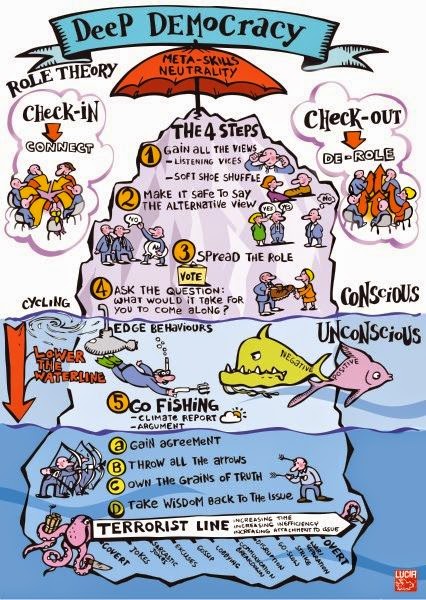Finding your Product Goal
In November 2020, the new Scrum Guide was released, mentioning for the first time a ‘Product Goal’. This block is designed to help you find your product goal. Attribution to The Liberators, the Scrum Guide and Harvard Business Review.
Preparation (online):
- Make a Mural from this template
- You need a video conferencing meeting with 'rooms' of up to 4 people
Preparation (physical):
- Super Sticky notes in at least 4 colours
- Print Elements of Value Pyramid as handout
- Flip-over sheets
- Flip-over of empty Elements of Value
- Flip-over of Wicked Questions
- Flip-over of Integrated ~ Autonomy
- Flip-over for Actions/Steps 15% Solutions
Theory 🧠 - Product Goal and Value
“A product is a vehicle to deliver value. It has a clear boundary, known stakeholders, well-defined users or customers. A product could be a service, a physical product, or something more abstract..”
Inside-Out
What then, is value? Traditionally, in project management, value was seen as being a function of the 'iron triangle': x budget, spent in x time, with x scope of solutions, will make the project "done". Quality is a cost to these variables, running out of time or money, whilst still making the same amount of scope, will lead to reducing the quality. This is working 'inside-out', from what we can make, towards value for customers.
Outside-In
Scrum turns this around. The Scrum team aims to continuously add maximum value for its customers. Scrum turns this 'outside in': the Scrum Team aims to continuously add maximum value for its customers. It does this by adding high quality work to the increment at least every sprint, ensured by a transparent definition of "Done".
from: https://youtu.be/r8Hqfy3pbm0
What is Value?
Exercise 🤲 - Wicked Questions
With Integrated ~ Autonomy you explore solutions that address both sides.
Make a list (10 min)
First alone, then in small groups, make a list of everything you know is true about value to your customer(s). Record that value on the blank Value Pyramid.
At the end it should look a bit like this:
- “How is it that you are raising your children to be very loyal/attached to the family and very independent individuals simultaneously?”
- “How is it that we want autonomous and self-managing Scrum Teams, and also keep moving in the same direction simultaneously?”
- “How is it that I value the freedom of knowledge, and I want to provide for my family simultaneously?”
Create Pairs (12 min)
First alone, then in small groups, generate pairs of opposites or pairs where there exists at least (creative) tension between the sides and both sides are positive, worthy goals.
Place the pairs on sticky notes on the blank wicked questions template:
Create Wicked Questions
First alone, then in small groups, create potential Wicked Questions out of the pairs by using the template:
“How is that we are [side 1] and [side 2], simultaneously?”
Reformulate the pairs so they fit in the template.
Select the Wicked Question that is the most important.
Results/Data 💖 Integrated ~ Autonomy
Wicked Questions are not something you can ‘solve’. Both sides represent an undeniable reality. Still, our thinking often makes us look for either/or solutions that affect only one side of the Wicked Question.
With Integrated ~ Autonomy you explore solutions that address both sides. Use the Integrated ~ Autonomy workarea to stick sticky notes to. At the top, add the two sides of your Wicked Question from the previous exercise.
- (6 min) First alone, then in small groups, develop actions/steps that help you achieve or strengthen the left side of the Wicked Question.
- (6 min) First alone, then in small groups, develop actions/steps that help you achieve or strengthen the right side of the Wicked Question.
- (6 min) First alone, then in small groups, consider actions/steps that help you achieve or strengthen both sides of the Wicked Question.
- (6 min) First alone, then in small groups, consider what modifications or creative ideas you can adopt to move some actions that strengthen the LEFT or the RIGHT side to support BOTH.
The end result should look something like this:
Insights/Conclusions 👀 - The Goal and 15% solutions
You should now be able to answer the following question:
- "What is value to your customer(s)?"
You also know the answer to the question:
- "How will you achieve that value?"
Formulate a Product Goal:
"To add [this value] for [this customer]. I will know the goal is achieved when [this customer] has [gained this value]."
N.B. a goal does not necessarily have to be SMART or achievable, that simply means that your Product will have to keep going and growing forever. In our example, the goal turned out to be
"To add the ability to publish, save and share their experiences, forever for everyone. I will know the goal is achieved when everyone has gained the ability to publish, save and share their experiences, forever."But you could also have:
"To add the pleasure of great coffee this week to my Scrum team. I will know the goal is achieved when my Scrum team have gained the pleasure of great coffee this week."
Identify Product Backlog Items:
Using the results from Integrated Autonomy, order the list of actions you found and for each action ask: "how can I make 15% progress on this action?". This should result in a list of some Product Backlog Items that you can do to achieve the Product Goal. Add those to your Product Backlog.










Comments
Post a Comment